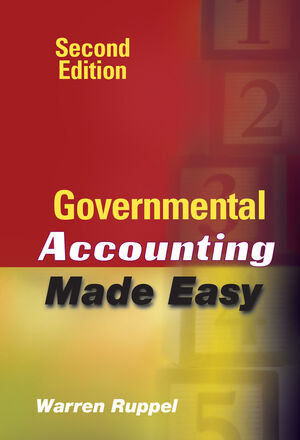Governmental Accounting Made Easy, 2nd EditionISBN: 978-0-470-41150-6
Hardcover
320 pages
October 2009
 |
||||||
Chapter 1 Introduction and Background.
What Are Generally Accepted Accounting Principles?
Who Sets Generally Accepted Accounting Principles for Governments?
Do Governments Need to Comply with Generally Accepted Accounting Principles?
Why Is Governmental Accounting and Financial Reporting Different from Commercial and Not-for-Profit Accounting and Financial Reporting?
To What Entities Do Governmental Generally Accepted Accounting Principles Apply?
Chapter 2 Basic Governmental Accounting Concepts.
Understanding the Different Bases of Accounting.
Understanding What Measurement Focuses Are Used by Governments.
Defining and Understanding the Nature of Assets.
Defining and Understanding the Nature of Liabilities.
Defining and Understanding the Nature of Net Assets.
Chapter 3 Understanding Fund Accounting.
Fund Fundamentals.
Governmental Funds.
Proprietary Funds.
Fiduciary Funds.
Chapter 4 Basics of Governmental Financial Statements.
General-Purpose Financial Statements.
Management’s Discussion and Analysis.
The Basic Financial Statements.
Required Supplementary Information.
Comprehensive Annual Financial Report.
Chapter 5 Understanding the Reporting Entity.
Background.
Accountability Focus.
Financial Reporting Entity Defined.
Display of Component Units.
Chapter 6 Revenues from Nonexchange Transactions.
Classes of Nonexchange Transactions.
Accounting Requirements.
Property Taxes.
Income and Sales Taxes, and Other Derived Tax Revenues.
Adjustments for the Accrual Basis of Accounting.
Grants and Other Financial Assistance.
Chapter 7 Capital Assets.
Where Are Capital Assets Recorded in the Financial Statements?
Recording and Valuing Capital Assets.
Understanding Depreciation.
Using the Modified Approach in Lieu of Depreciating Infrastructure Assets.
The Basics of Capitalized Interest.
Capital Assets Resulting from Capital Lease Transactions.
Intangible Assets.
Impairments of Capital Assets.
Chapter 8 Accounting for Pensions and Other Postemployment Benefits.
Requirements for Defined Benefit Pension and OPEB Plans.
Calculation of the ARC.
Parameters for Actuarial Calculations, Including the ARC.
Net Pension or OPEB Obligation.
Recording Pension- and OPEB-Related Assets, Liabilities, and Expenditures/Expenses.
Pension and OPEB Disclosures.
Employers with Defined Contribution Plans.
Chapter 9 Sundry Accounting Topics.
Accounting for Investments.
Reporting Unrealized Gains or Losses.
Investment and Deposit Disclosures.
Compensated Absence Accruals.
Landfill Closure and Postclosure Care Costs.
Derivatives, Including Interest Rate Swaps.
Securities Lending Transactions.
Chapter 10 Upcoming Developments in Governmental Accounting.
Pension (and OPEB) Accounting—Revisited.
Index.



